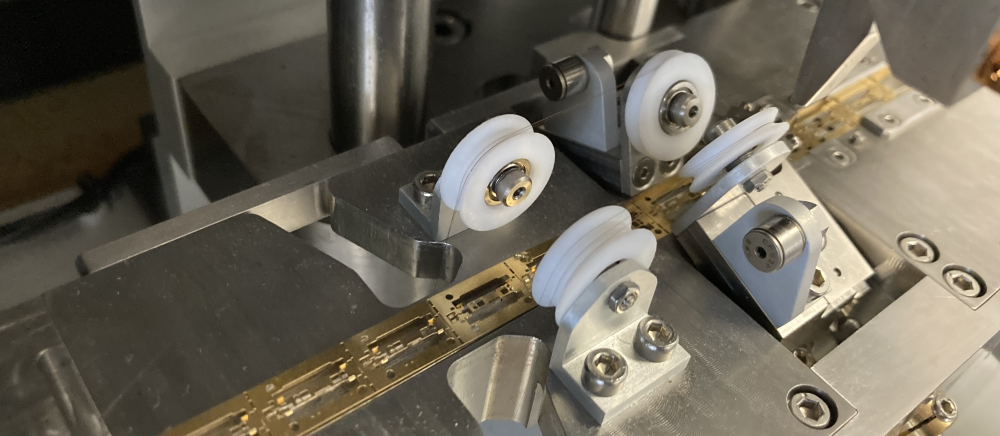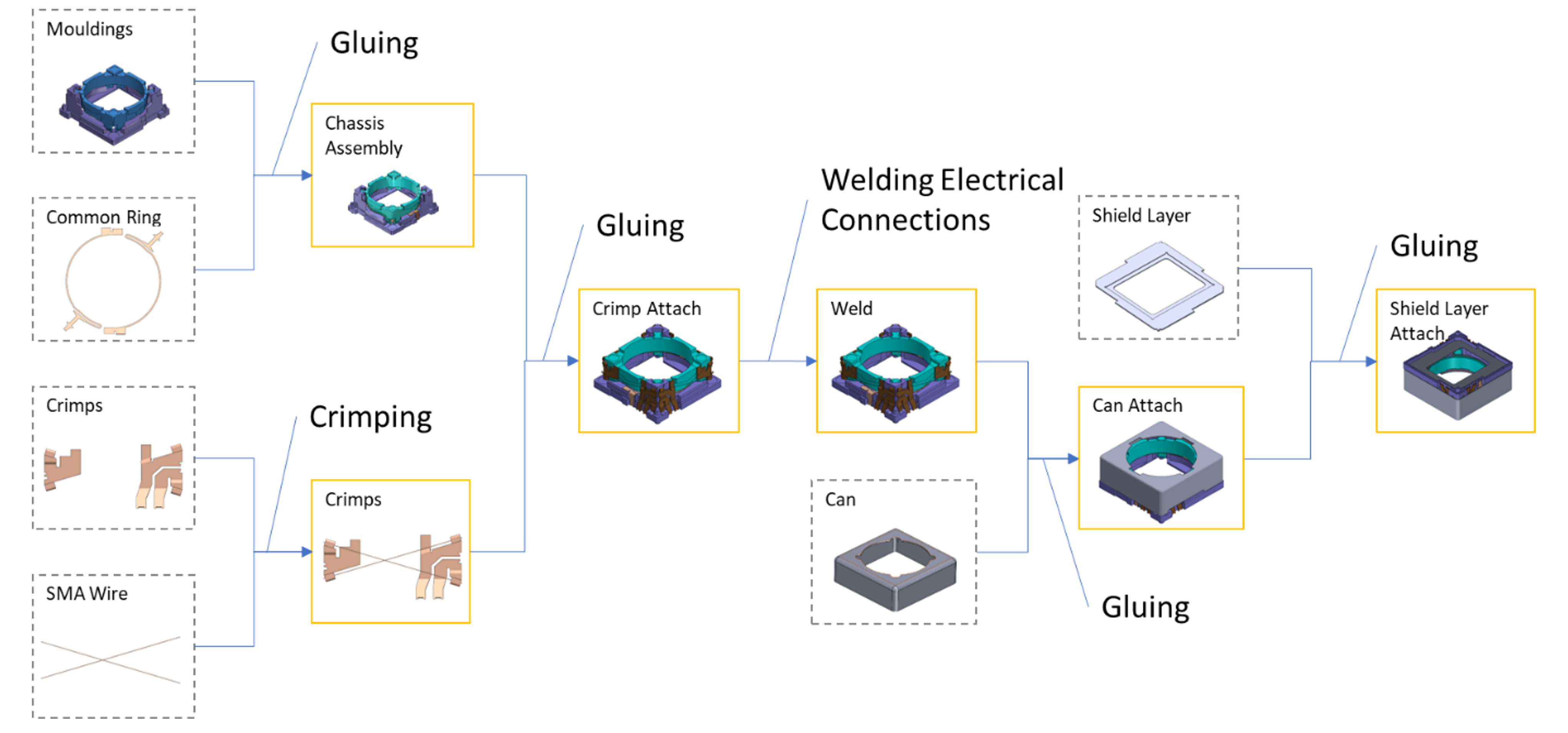15 Feb 2024
Manufacturing SMA actuators for smartphone camera systems
By Reto Klopfenstein, Senior Mechanical Engineer
Cambridge Mechatronics Ltd (CML) is the world leader in developing Shape Memory Alloy (SMA) actuator technology that is gaining increased adoption in the smartphone camera market. In this article, we show you that SMA actuators are manufactured using standard in-line production techniques. This approach enables manufacturers to achieve high production yields in their assembly processes.
SMA actuators
SMA actuators are a critical hardware component in smartphone cameras for delivering optical image stabilisation (OIS) and autofocus (AF). These actuators will typically move a lens array or image sensor during use, with sub-micron movements controlled by CML algorithms on dedicated SMA driver chips. Information on the make-up and mechanical design of an SMA actuator can be found in this article: The essential components of SMA actuators and how they shape our smartphone cameras

Figure 1: Components of an SMA Lens Shift AF+OIS actuator
The example SMA actuator in the figure above is made up of multiple assembled components. Each component (or part) requires different manufacturing methods to prepare before assembling into the completed actuator, which we describe in more detail below.
Manufacturing and assembly processes
Figure 2 shows the basic manufacturing process flow.

Figure 2: Basic linear manufacturing process for SMA smartphone camera actuators
Each of these steps are described in sequence in the following sections using examples from the manufacturing and assembly of an SMA actuator that is currently in mass production.
1. Part manufacturing
In mass production, metal sheets undergo chemical etching and/or stamping to deliver basic desired shapes and plastic components are injection moulded. These standard manufacturing processes are designed for high repeatability and throughput, which ensure the intricate parts are made to the required precision and tolerances.
In Figure 1, the Common Ring, the Crimps and the Shield Layer are etched or stamped, and the Lens Carriage and Chassis are injection moulded. The etched Common Ring and moulded Chassis are shown in Figure 3.
Injection moulding process: Injection moulding is a widely used method for producing parts from both thermoplastic and thermosetting plastic materials. In this process, the raw material is heated until it melts and is then injected under pressure into a mould cavity. This mould is precision-engineered to the exact specifications of the part to be manufactured. Once the molten material is injected into the mould, it cools and solidifies into the shape of the cavity. Injection moulding is ideal for producing high volumes of identical parts with complex geometries and excellent surface finish. The process is highly efficient and cost-effective for mass production due to its high production rate, repeatable high tolerances, and minimal waste.
Etching process: Etching is a subtractive manufacturing process where specific areas of a metal sheet are selectively removed using a chemical solution, typically an acid. The process begins with the application of a resistant layer, often a photoresist, on the metal sheet, following a desired pattern. This pattern represents the final component shape. When the metal sheet is immersed in an acid bath, the areas not covered by the resistant layer are dissolved or 'etched away', while the protected areas remain intact. This method is highly effective for creating intricate and detailed patterns. It is particularly useful for prototype development due to its flexibility in design changes. However, for high-volume production, etching can be less cost-effective compared to other methods due to the slower processing time and the need for handling chemicals.

Figure 3: [left] The SMA actuator Common Ring component (as shown in Figure 1) is etched from sheet metal and [right] injection moulded Chassis component for SMA Actuator
Stamping process: Stamping, also known as pressing, involves shaping, cutting or bending metal sheets by mechanically deforming them with a die and a stamp (or punch). The die and stamp are custom-made tools, precisely machined to the desired shape of the final part. During the stamping process, the metal sheet is placed between the die and the stamp. The stamp then forcefully presses into the metal sheet, causing it to conform or cut to the shape of the die. This method is highly efficient for mass production because it allows rapid processing of large volumes of metal sheets with consistent and precise results. Stamping is favoured in industrial settings for its cost-effectiveness, high throughput, and ability to produce parts with tight tolerances.
In many mass-production environments, all sheet metal parts of the actuator are stamped. In the example shown in Figure 1, the Shield Layer, Crimps, Common Ring, and the Shield Can are stamped. The Shield Can is made in multiple steps of both stamping and deep drawing. Deep drawing is also a type of stamping technique, which is involved in the part forming process, as described below.
2. Part forming
Once the basic shapes are available, the metal parts undergo additional forming processes like bending and deep drawing to achieve the desired 3D structures. This process includes creating raised elements, essential for actuator functionality. These steps are carried out using standard sheet metal forming tools.
The components shown in Figure 1 that require a forming process include the Shield Can (deep drawn), Common Ring and Crimps (using bending techniques), with an example of a Shield Can shown in Figure 4 below. Deep drawing is a commonly used sheet metal forming process, where the flat sheet metal is formed into the shape of a die with a punch applying force to it.

Figure 4: Deep drawn Shield Can
3. SMA crimping
The most critical step in assembling an SMA actuator is attaching the SMA wires to the static and moving components of the actuator. This is commonly referred to as the crimping process, which CML has pioneered for SMA actuators. This step is a combination of both the part forming (bending) and the assembly manufacturing processes. SMA wire crimping is now used in the assembly of millions of SMA actuators/month across multiple manufacturing sites.
In simple terms, this step involves guiding the SMA wires into pre-formed grooves in the crimp metal and stamping the metal down so that the wire is firmly gripped by the crimp and therefore attached to the actuator.

Figure 5: SMA crimping process: [1] Flat sheet metal as etched or stamped; [2] 90° bend; [3] 150° bend; [4] Crimped wire
CML has optimised the crimping process for a strong mechanical and electrical bond, developing an in-line process that gives a high degree of precision, repeatability and product reliability. Mass production often involves robotic arms and specialised equipment to ensure high yields.

Figure 6: The SMA wires (seen over the white spools) are attached to metal crimps in a semi-automated and controlled process developed by CML
4. Assembly
The assembly process follows a standard sequence of automated steps. The subassemblies are brought together in a specific order and attached using known and controlled operations such as laser welding and glueing. The example below shows the components in Figure 1 coming together.
 Figure 7: Basic assembly processes for SMA smartphone camera actuators
Figure 7: Basic assembly processes for SMA smartphone camera actuators
5. Inspection and testing: ensuring quality in every step
Inspection points should be embedded throughout the assembly line to ensure only the highest quality actuators are produced. Advanced techniques, including image recognition, are employed in mass production for early identification and elimination of process deviations. Regular checks, especially on critical processes like crimping, are essential to maintain the integrity and functionality of the actuators.
Standard processes, exceptional outcomes
At CML, the focus on using standard and high-yielding manufacturing processes ensures efficiency, affordability, and high-quality outcomes in SMA actuator production. This approach has allowed CML’s manufacturing licensees to mass produce SMA actuators at high throughput and yield. CML remains committed to developing new SMA actuator designs consistent with a minimal component count and maximum compatibility with known and proven mass production processes. Contact CML for further information or questions about manufacturing compact SMA actuators for smartphone cameras.
About CML: Cambridge Mechatronics Limited (CML) is a world-leading developer of mechanical, optical, electrical, silicon, and software designs for system-level solutions using its Shape Memory Alloy (SMA) platform technology. ACTUATOR SOLUTIONS based on SMA wire (thinner than human hair) can be controlled to submicron accuracy. These actuators are particularly suited to applications requiring high precision and force levels, in a fast, compact, and lightweight design.
For more details about SMA technology and Cambridge Mechatronics, please GET IN TOUCH.
